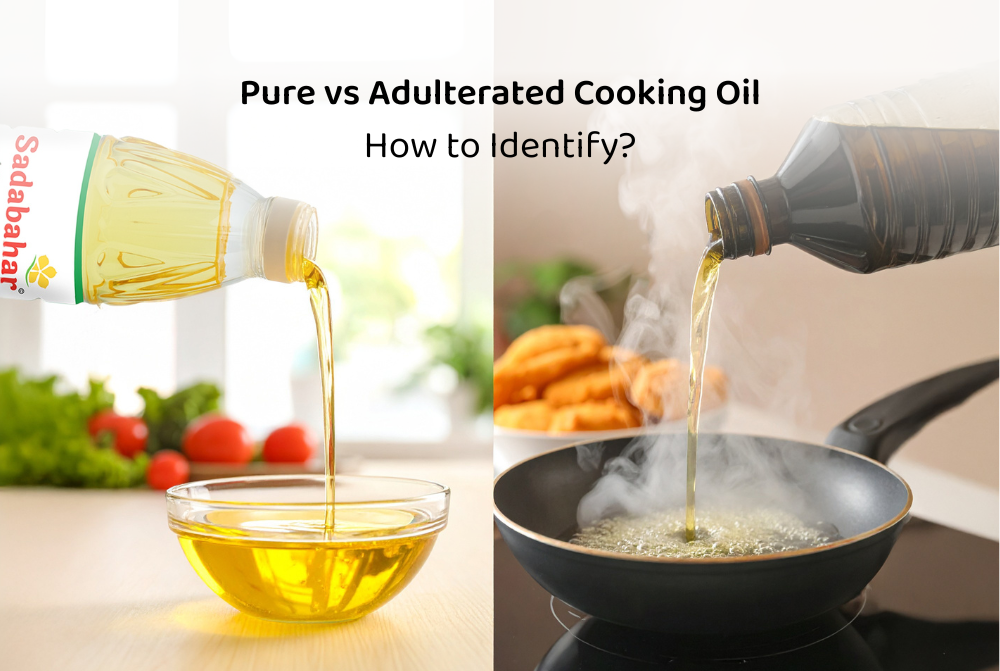How to Identify Pure vs. Adulterated Cooking Oil?
According to reports, nearly 25% of food in Rajasthan was found adulterated in 2024. Every other day, we hear about adulteration in food. Whether it is paneer, milk, spices, or even grains, many ingredients we trust are no longer as pure as they once were. Most of us can spot adulteration in food by a change in texture, smell, or taste. However, one ingredient that is a little difficult to differentiate between authentic and not is cooking oil.
Cooking oil is the base of almost every meal in India. It's used for tempering, sauteing, and frying. Yet we aren't aware of whether we are using adulterated or pure cooking oil. The effects of impure oil can cause severe health issues, such as allergies, skin issues, rashes, fatty liver, cholesterol, dementia, and gut issues. In extreme cases, it can also cause cancer.
This blog is a simple guide to help you identify pure cooking oil, understand the difference between pure vs adulterated cooking oil, and learn a few easy ways to test oil purity at home.
What is Oil Adulteration?
Oil adulteration is the process of mixing pure edible oil with cheaper or non-edible substances to increase quantity and reduce production costs. These additives may not be harmful in appearance, but they can be toxic, unhealthy, or even unsafe for human consumption.
In many cases, oils like palmolein, castor oil, mineral oil, paraffin wax, cottonseed oil, or even cheap industrial oils are blended with refined cooking oils such as mustard, groundnut, soybean, sesame, rice bran, or sunflower oil. This not only affects the nutritional quality of the oil but also puts your health at serious risk.
The main reason behind adulteration is profit-making, which comes at the cost of the consumer's well-being. Unfortunately, the signs of adulteration in oil are hard to detect without proper knowledge or testing. This makes it even more important for consumers to stay informed
Pure vs. Adulterated Cooking Oil: What's the Difference?
Pure cooking oil is extracted naturally from high-quality seeds or nuts. It undergoes hygienic, FSSAI-certified processes that adhere to food and health safety standards. It has clear labelling, including the manufacturing date, ingredient list, and shelf life. Pure oil is free from harmful additives and retains its natural colour, aroma, and nutritional benefits.
In contrast, adulterated cooking oil packs or bottles lack these parameters. It may be poorly refined, mislabelled, or contain unwanted additives.
Here are some commonly adulterated oils and their adulterants:
| Cooking Oil | Adulterants |
|---|---|
| Coconut oil | Argemone oil |
| Mustard oil | Paraffin wax, palm oil |
| Groundnut oil | Cottonseed oil |
| Olive oil | Inferior quality vegetable oil |
| Soybean oil | Mineral oil, palm oil |
| Sesame oil | Castor oil |
| Sunflower oil | Palmolein, mineral oil |
| Rice bran oil | Soybean oil, palm oil |
How to Identify Adulteration in Cooking Oil?
The following are some quick ways to identify adulteration in cooking oil:
Check the Label
Look for FSSAI certification
Ensure there are no added mineral oils or artificial colours
Check for batch number, expiry date, and manufacturer details
Prefer cold-pressed or filtered oils from trusted brands like Sadabahar.
2. Observe Colour and Smell: Pure oils have a natural colour and a mild fragrance. If your oil smells synthetic or is unusually dark, it might be adulterated.
3. Foaming on Heating: Adulterated oils often foam excessively when heated. If the oil produces a lot of smoke early, it indicates adulteration.
4. Pricing: If the oil is significantly cheaper than market rates, it could be mixed with low-quality ingredients or harmful alternatives.
How to Check Cooking Oil Purity at Home?
You don’t need lab equipment to test cooking oil. Here are some simple and safe methods using basic kitchen tools and a little observation:
1. Mustard Oil
Smell the oil. Pure mustard oil has a strong, pungent aroma.
Heat a small amount in a pan. If it gives off a sharp, irritating smell or foams excessively, it might be adulterated.
2. General Edible Oils
Pour a spoonful of oil into a clear glass and refrigerate it for 30–40 minutes.
If it becomes cloudy or shows two separate layers, the oil might be mixed with other low-quality oils.
3. Sesame Oil
Pour a little sesame oil on a white paper.
Let it sit for a while. It may be adulterated if the paper turns sticky or greasy and doesn’t dry easily.
4. Coconut Oil
Keep coconut oil in the fridge. Pure coconut oil solidifies completely in cold temperatures.
If it stays partly liquid or separates, there’s a high chance it’s mixed with other oils.
5. Soybean Oil
Taste a drop of raw oil. Pure soybean oil has a neutral flavour.
It may contain impurities if it tastes bitter or leaves a tingling or unusual aftertaste.
Choose Purity, Choose Health with Sadabahar
Every food product or ingredient seems fine until it starts impacting your health. So why wait until something causes serious health issues? Prevention is better than cure, and choosing healthy and safe cooking oil for your family is a wise choice.
At Sadabahar, we help make that choice easier. Our oils are pure, FSSAI-certified, and made from high-quality seeds under strict safety standards. You can trust us if you are looking for the best cooking oil supplier in Rajasthan.
Frequently Asked Questions - FAQs
-
Ans: Yes. Loose oil is more prone to contamination and adulteration. It usually lacks quality checks, expiry info, and FSSAI certification. It’s always safer to buy oil from reputable, labelled brands.
-
Ans: While basic home tests (like refrigeration or checking for residue) give clues, they are not foolproof. They are helpful in identifying signs, but certified lab testing or choosing trusted brands remains the safest option.


